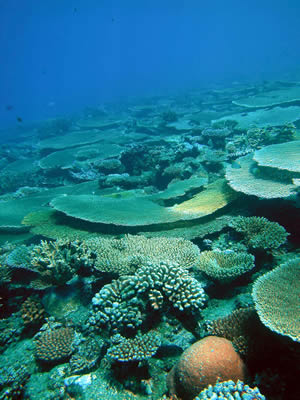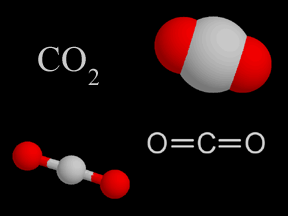Click on image for full size
Credit: UNC
Pacific Coral Reefs May Not Get Into Hot Water
News story originally written on February 7, 2008
Coral animals build reefs in warm, tropical seawater. However, seawater can be too warm for their liking. If waters get too warm, coral animals loose the algae that live within their little bodies, a process called coral bleaching. Without the algae, corals have less nutrition. Unless cooler temperatures return, allowing algae to return, the coral dies. So as water temperature climbs, corals become less healthy.
As our planet warms, the oceans also warm, which could be bad news for corals. The surface temperature of tropical waters has increased about 0.5 to 0.7 degrees Fahrenheit (0.3 to 0.4 degrees Celsius) over the last 20 to 30 years, and temperatures sometimes spike higher. Reefs in areas of the tropics where water temperature has risen have been vulnerable to bleaching.
However, new research has found that natural processes might stop areas of the ocean from warming too much for corals to survive. If so, then some of the world's largest coral reefs might be protected from climate change.
A team of scientists, led by Joan Kleypas of the National Center for Atmospheric Research, looked at an area of the Pacific Ocean northeast of Australia. They studied records of temperature at the ocean surface and records of coral bleaching. They also used a climate model to simulate ocean temperatures.
They found evidence that the temperature of seawater might be kept in check by natural processes. While tropical seas have warmed in the past few decades, the temperature has not changed much in this area of the Pacific. The coral reefs there have stayed healthy and have not suffered much bleaching.
Their study supports the hypothesis that natural processes prevent temperatures of the ocean surface from warming beyond a certain point. What might stop the water from warming? As water warms, more water evaporates. Evaporation removes heat. It also can increase the number of clouds that make shade and increase winds that cool the surface. In some areas, warmer water changes ocean currents that mix in cooler waters.
Even if there is a limit to ocean warming, coral reefs in other regions of the world may not be so lucky. Corals that live in slightly cooler waters will experience much more temperature change as the water warms towards the limit. In addition to warming seawater, coral reefs face many other threats - carbon dioxide, diseases, overfishing, and pollution to name a few.
"Warming waters are just one part of the picture, but they are an important part," says Joan Kleypas.















